Hassani S. Mathematical Physics: A Modern Introduction to Its Foundations
Подождите немного. Документ загружается.

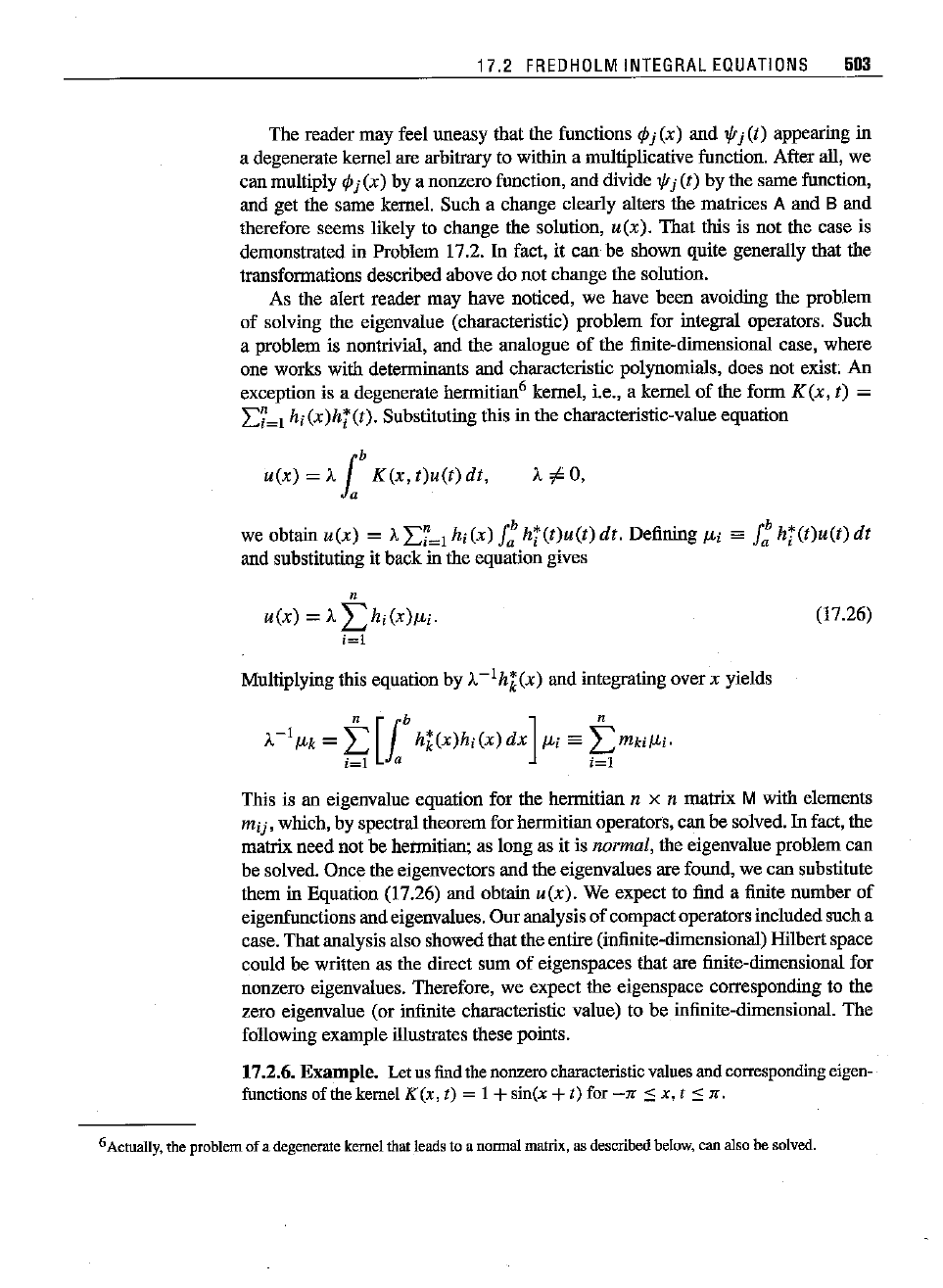
17.2
FREDHOLM
INTEGRAL
EQUATIONS
503
The reader may feel uneasy that the functions
<P
j (x) and
Vr
j (t) appearing in
a degenerate kemel are arbitrary to within a multiplicative function. After
all, we
can multiply
<Pj(x) by a nonzero function, and divide
Vrj(t)
by the same function,
and get the same kemel. Such a change clearly alters the matrices
A and B and
therefore seems likely to change the solution,
u(x).
That this is not the case is
demonstrated in Problem 17.2.
In fact, it can be shown quite generally that the
transformations described above do not change the solution.
As the alert reader may have noticed, we have been avoiding the problem
of solving the eigenvalue (characteristic) problem for integral operators. Such
a problem is nontrivial, and the analogue
of
the finite-dimensional case, where
one works with determinants and characteristic polynomials, does not exist.
An
exception is a degenerate hermitian'' kemel, i.e., a kemel
of
the form K (x, t) =
L:?~l
hi(X)h~(t).
Substituting this in the characteristic-value equation
u(x)
=
Alb
K(x,
t)u(t)
dt,
we obtain
u(x)
= A
L:?=l
hi (x)
f:
h~(t)u(t)
dt.
Defining
I-'i
sa
f:
h~(t)u(t)
dt
and substituting it backin the equation gives
n
u(x)
= A
I)i(x)l-'i.
i=l
Multiplying this equation by A
-lh;;(x)
and integrating over x yields
(17.26)
This is an eigenvalueequation for the hermitian n x n
matrix
Mwith elements
mi],
which, by spectral theorem for hermitian operators, can be solved.
In
fact, the
matrix need not be hetmitian; as long as it is
normal, the eigenvalue problem can
be solved. Once the eigenvectors and the eigenvalues are found, we can substitute
them in Equation (17.26) and obtain
u
(x).
We expect to find a finite number of
eigenfunctions and eigenvalues. Our analysis of compactoperatorsincludedsuch a
case. That analysis also showed that the entire(infinite-dimensional) Hilbert space
could be written as the direct sum of eigenspaces that are finite-dimensional for
nonzeroeigenvalues. Therefore, we expect the eigenspace corresponding to the
zero eigenvalue (or infinite characteristic value) to be infinite-dimensional. The
following example illustrates these points.
17.2.6. Example. Let us
find
the
nonzero
characteristic
values
and
corresponding
eigen-
functions of the kernel
K(x,
t) = 1 +sin(x + t) for
-Jl'
::0
X.
t
::0
n,
6
Actually,
the
problem
of a
degenerate
kernel
that
leadsto anormal
matrix,
as
described
below,canalsobesolved.

504 17.
INTEGRAL
EQUATIONS
We are seeking functions u and scalars Asatisfying
u(x)
= AK[u](x), or
u(x)
= A
i:
[I +sin(x +
t)lu(t)
dt.
Expanding sin(x +
t),
we obtain
u(x)
=)"
L:
[1 +sinx cos t +cos x
sint]u(t)
dt,
or
A
-lu(x)
=
ILl
+IL2sinx +
JL3
COSX,
(17.27)
(17.28)
where
1'1 = f':.n
u(t)
dt,
!'2
= f':.n
u(t)
cost
dt,
and
!'3
= f':.n
u(t)
sin t dt. Integrate
both sides
of
Equation (17.28) withrespect to x from
-rr
to
1C
to obtain
A-I
JL
1 =
23l'
JL
1.
Similarly,
multiplying
bysin x andcosx and
integrating
yields
and
(17.29)
If
1'1
i'
0, we get A
-I
= 2,.., which, whensubstituted in (17.29),
yields!'2
= 1'3 =
O.
We
thus
have,
asa first
solution,
All
=
2Jr
and
lUI)
=
a(6),
where
a is an
arbitrary
constant.
o
Equation (17.28) now gives
Ai1uI(X)
= 1'10 or UI(X) = cj , where
Cj
is an arbitrary
constant
tobe
determined.
On the other hand, 1'1 =0
in
-I
i'
2,... ThenEquation (17.29) yields A
-I
=
±,..
and
1'2 = ±1'3·For A
-I
==
1.+
1
=,..,Equation (17.28) gives
u(x)
ea
u+(x)
=
c+(sinx
+
cosx),
andforA-I
==
).,=1
=
-Jr,
it yields
u(x)
ss
u_(x)
= c_{sinx - COS
x),
where
c± are
arbitrary
constants
to bedetermined by
normalization
of eigenfunctions. The
normalized
eigenfunctions are
I
U1=
$'
u±(x)
=
~(sinx
± cos
x).
v 2,..
Direct
substitution
in the
original
integral
equation
easily
verifies
that
UI,'
U+,
and
u.:
are
eigenfunctions
ofthe
integral
equation
withtheeigenvalues
calculated
above.
Letusnow
consider
thezero
eigenvalue
(or
infinite
characteristic
value).
Divideboth
sides
of
Equation (17.27) by Aand take the limit
of
A
-+
00.
Then the integral equation
becomes
L:
[1+sinx
cost
+cos x
sint]u(t)
dt
=
O.
Thesolutions
u(t)
to this
equation
wouldspantheeigenspace
corresponding
to thezero
eigenvalue,
or
infinite
characteristic
value.
We
pointed
out above
that
thiseigenspace is
expected
to be
infinite-dimensional.
This.
expectation
is
borne
out once we note
that
all
functions
of the
form
sin
nt
orcosnt withn
~
2 makethe
above
integral
zero;
and
there
are
infinitely many such
functions.
III

17.3
PROBLEMS
505
17.3 Problems
17.1. Use mathematical induction to derive Equation (17.5).
17.2. Repeat part (a) of Example 17.2.5 using
¢2(x)
=
x,
'h(t)
= t
so that we still have
K(x,
t) =
4>1
(X)1/tl(t) +¢2(X)1/r2(t).
17.3. Use the spectral theoremfor compacthermitian operators to show that
if
the
kernel of a Hilbert-Schmidt operator has a finite number of nonzero eigenvalues,
then the kernel is separable. Hint: See the discussion at the beginning of Section
17.2.1.
17.4. Use the method of successive approximations to solve the Volterra equation
u(x)
= Ag
u(t)dt.
Then derive a DE equivalent to the Volterra equation (make
sure to include the initial condition), and solve it.
17.5. Regard the Fourier transform,
I 1
00
F[f](x)
sa
--
e
ixy
fey)
dy
,J2ir
-00
as anintegral
operator.
(a) Show that F
2[f](x)
=
fe-x).
(b) Deduce, therefore. that the only eigenvalues of this operator are A= ±I,
±i.
(c)
Let
f(x)
be any even function of
x.
Show that an appropriate choice of a can
make
u = f +
aF[f]
an eigenfunction of F. (This shows that the eigenvalues of
Fhave infinite multiplicity.)
17.6. For what values of Adoes the following integral equation have a solution?
u(x)
= A
10"
sin(x +
t)u(t)
dt
+
x.
What
is that solution? Redo the problemusing a Neumann series expansion. Under
whatcondition is theseries
convergent?
17.7.
It
is possible to mnltiply the functions 4>j(x) by
rj(x)
and 1/rj(t) by
I!yj(t)
and still get the same degenerate kernel,
K(x,
t) =
I:j=1
4>j
(x)1/rj(t). Show that
such arbitrariness, although affecting the matrices A and S, does not change the
solution of the Fredholm problem
u(x)
-
Alb
K(x,
t)u(t)dt
=
f(x).
17.8. Show, by direct substitution, that the solutionfound in Example 17.2.4 does
satisfy its integral equation.
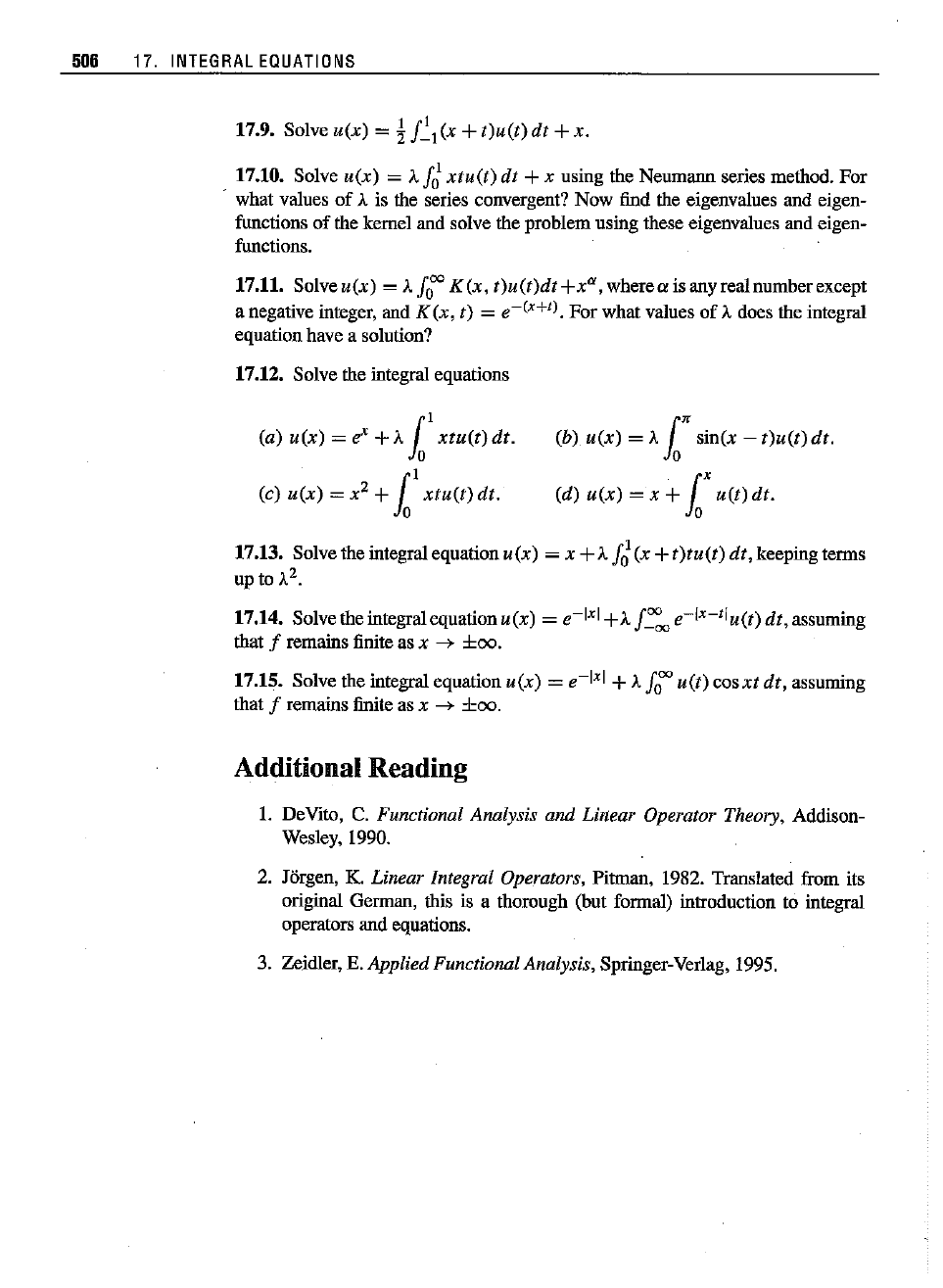
506 17. INTEGRAL
EQUATIONS
17.9. Solve
u(x)
= !
f~1
(x +
t)u(t)
dt
+x.
17.10. Solve
u(x)
=
),.
f~
xtu(t)
dt
+x using the Neumann series method.
For
. what values
of)"
is the series convergent? Now find the eigenvalues and eigen-
functions
of
the kernel and solve the problem using these eigenvalues and eigen-
functions.
17.11. Solve
u(x)
=
),.
f
o
oo
K(x,
t)u(t)dt+x
a,
where", is any realnumberexcept
a negative integer, and
K(x,
t) =
e-(x+I).
For
what
values
of)"
does the integral
equation have a solution?
17.12. Solve the integral equations
(a)
u(x)
=
eX
+),.
fol
xtu(t)dt.
(c)
u(x)
= x
2
+
fol
xtu(t)
dt.
(b)
u(x)
=),.
fo"
sin(x -
t)u(t)
dt.
(d)
u(x)
= x +foX
u(t)
dt.
17.13. Solve the integral equation
u(x)
= x
+),.
f~(x
+t)tu(t)
dt,
keeping terms
upto),.2.
17.14. Solve the integralequation
u(x)
=
e-
ixi
+),.
f.""oo
e-1x-11u(t)
dt,
assuming
that
f remains finite as x
-->
±oo.
17.15. Solve the integral equation
u(x)
=
e-
ixi
+),.
fo
oo
u(t)
cosxt
dt,
assuming
that
f remains finite as x -->
±oo.
Additional Reading
1. DeVito, C. Functional Analysis and Linear Operator Theory, Addison-
Wesley, 1990.
2. Jiirgen, K.
Linear Integral Operators, Pitman, 1982. Translated from its
original German, this is a thorough (but formal) introduction to integral
operators and equations.
3. Zeidler, E.
AppliedFunctional Analysis, Springer-Verlag, 1995.
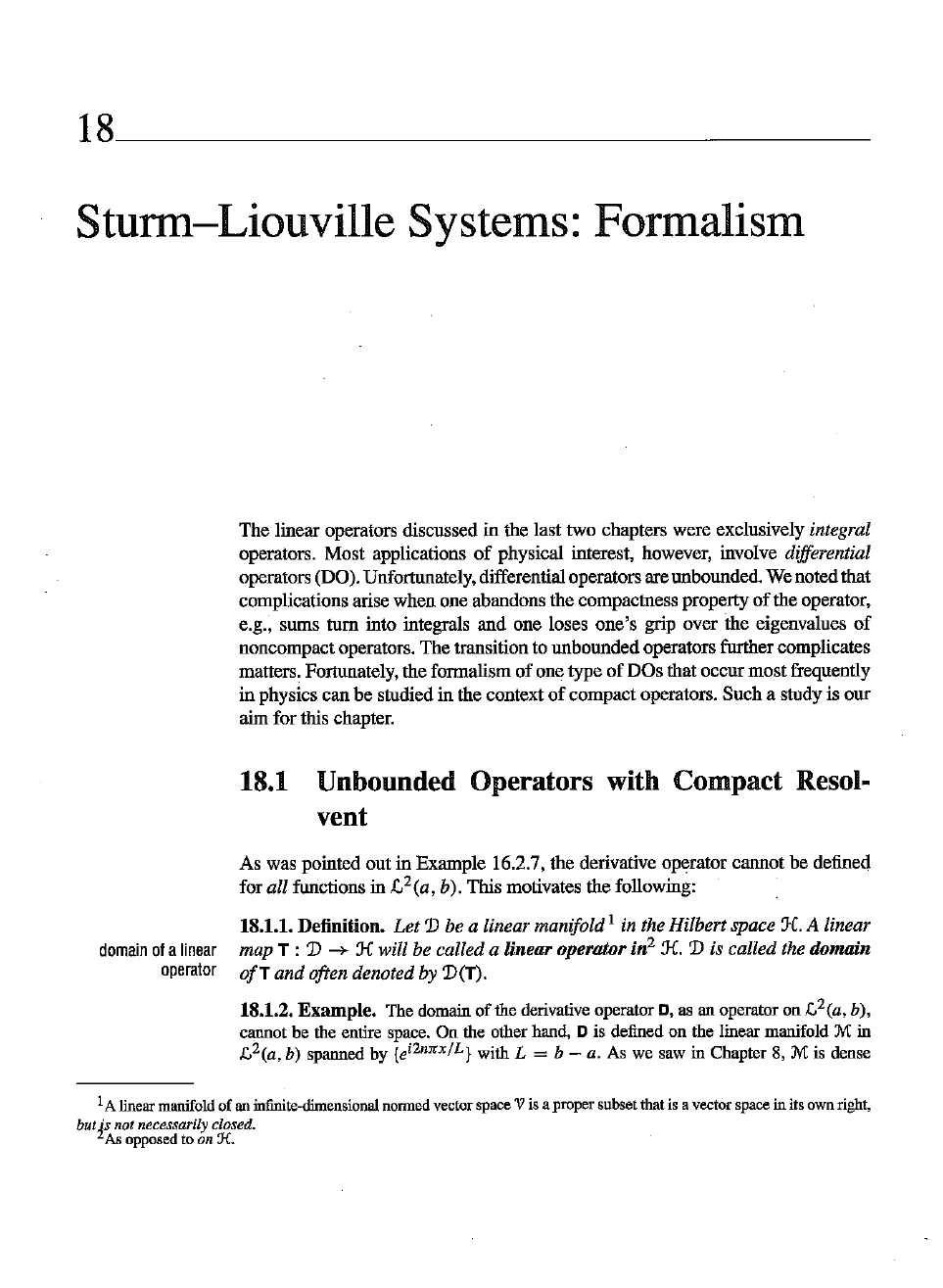
18,
_
Sturm-Liouville Systems: Formalism
The linear operators discussed in the last two chapters were exclusively integral
operators. Most applications
of
physical interest, however, involve differential
operators (DO). Unfortunately,differentialoperatorsare unbounded. We noted that
complications arise when one abandons the compactness property of the operator,
e.g., sums tum into integrals and one loses one's grip over the eigenvalues of
noncompact operators. The transition to unbounded operators further complicates
malters. Fortunately, the formalism of one type of DOs that occurmost frequently
in physics can be stndied in the context
of
compactoperators. Such a stndy is our
aim for this chapter.
18.1 Unbounded Operators with Compact Resol-
vent
domain
ofa
linear
operator
As was pointed out in Example 16.2.7, the derivative operator cannot be defined
for
all functions in .(,2(a, b). This motivates the following:
18.1.1. Definition.
Let
D be a linear manifold1 in the Hilbert space
11:.
A linear
map
T :
:D
-->
11:
will be calleda linear operator
in
2
11:.
:D
is called the domain
ofT
and
often denoted by
:D(T).
18.1.2.
Example.
The domainof the derivative operatorD, as anoperatoron£,2(a, b),
cannot be the entire space. On the other hand, Dis defined on the linear manifold M in
£,2(a. b) spannedby (ei2nrrx/Lj wiih L = b - a. As we saw in Cbapter8, :M is dense
1A linear manifoldofan infinite-dimensional normedvectorspace
'\7
is a propersubsetthat is a vectorspacein its ownright,
butls notnecessarilyclosed.
As opposed to on X.

508
18. STURM-LIOUVILLE SYSTEMS: FORMALISM
(see Definition 16.4.5 and the discussion following it) in
~2(a,
b). This is the essence
of
Fourier
series:
That
every
function
int.}(a, b) canbe
expanded
in (i.e.,
approximated
by)
a
Fourier
series. It
turns
out thatmanyunbounded
operators
on a Hilbertspace sharethe
same
property,
namely
that
their
domains
aredensein the
Hilbert
space.
Another important property
of
Fourier expansion is the fact that if the function is
differentiable,
thenone can
differentiate
both sides, i.e., one can
differentiate
a
Fourier
expansion
term
by
term
if
such
an
operation
makes
senseforthe
original
function.
Define
the sequence
(f
m) by
m
fm(x) = L uni2rrnx/L,
n=-m
1 l
b
.
a'l =
.JL
a !(x)e-l271:nxjLdx.
Then wecan statethepropertyaboveasfollows:Soppose
(fm)
is in
M.lflim
[m = I and
lim
I:"
=g, thenI' = g andI E M. Manyunboundedoperatorssharethisproperty. iii
18.1.3. Definition. Let
:D
be a linear manifold in the Hilbert space Jf. Let T :
:D
--'>
Jf
be a linear operator in Jf. Suppose that for any sequence {Iu
n))
in D,
both {Iu
n
))
and {Tlu
n
)}
converge in
Jf,
i.e.,
lim lu
n
)
= lu)
and
lim
T lu
n)
= Iv) .
difference
between
hermitian
and
self-adjoint
operators
closed
operator
We say
thatT
is closed
iflv)
E
:DandTlu)
= [u).
Notice that we cannot
demand
that Iv) be in
:D
for a general operator. This, as
we saw in the precedingexample, will
not
be appropriatefor unboundedoperators.
The
restriction
of
the domain
of
an
unbounded
operator is necessitated by
the
fact that the action
of
the
operatoron a vectorin
the
Hilbert space in general takes
that vector
out
of
the space.
The
following theorem (see [DeVi 90, pp.
251-252]
for a
proot)
shows
why
this is necessary:
18.1.4.
Theorem.
A closed linear operator in
Jf
that is defined at every point
of
Jf
(so that :D=
Jf)
is bounded.
Thus,
if
we are interested in unbounded operators (for instance, differential
operators), we
have to restrict
their
domains. In particular, we have to accept
the
possibility
of
an operatorwhose adjointhas a different domain.f
18.1.5. Definition.
Let Tbea linear operatorin
Jf.
Weshall say thatTishermitian
ifTt
isan extensionofT,i.e., :D(T) C :D(Tt)
andTt
lu) = T
lu)foralllu)
E :D(T).
T
is called self-adjoint if:D(T) = :D(Tt).
operators
with
compact
resolvent
As we shall see shortly, certain types
of
Sturm-Liouville
operators, although
unbounded, lend themselves to a study within
the
context
of
compact
operators.
18.1.6. Definition.
A hermitian linear operator T in a Hilbert space
Jf
is said to
have a compactresolvent
if
there is a I-' E P(T) for which the resolvent R" (T) is
compact.
3Thissubtle
difference
between
hermitian
and
self-adjoint
is statedheremerelytowarnthe
reader
andwill be
confined
to the
present
discussion. Thetwo
qualifiers
will be
(ab)used
interchangeably
intherestof thebook.
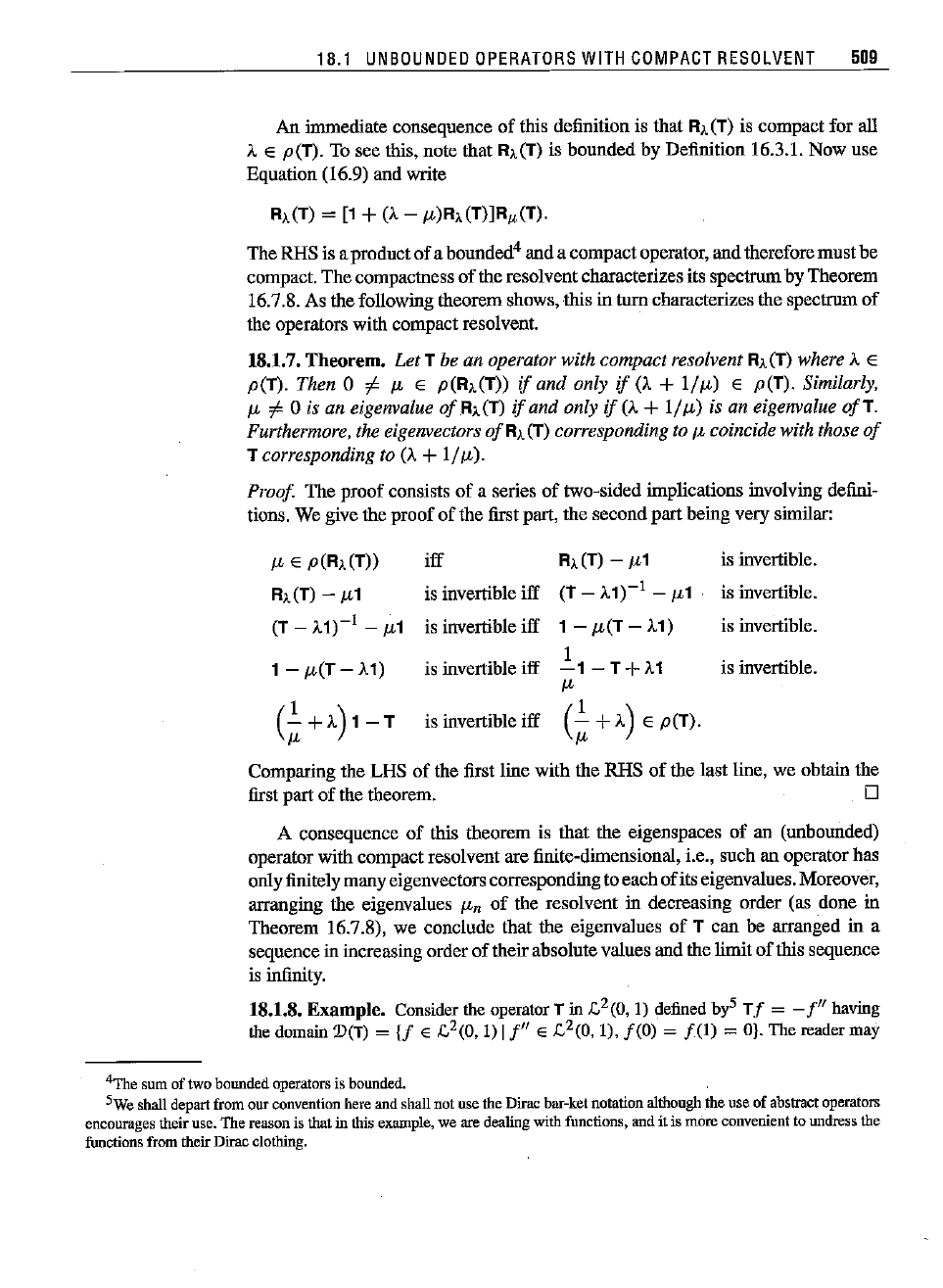
18.1
UNBOUNOEO
OPERATORS
WITH
COMPACT
RESOLVENT
509
An immediate consequence
of
this definition is that R, (T) is compact for all
A E
pen.
To see this, note that
R,(T)
is bounded by Definition 16.3.1.
Now
use
Equation (16.9) and write
The RHS is a product
of
a bounded"
and
a compactoperator, and therefore
must
be
compact.
The
compactness
of
the resolventcharacterizesits spectrumby Theorem
16.7.8. As the following theorem shows, this in
tnrn
characterizes the spectmm
of
the operators with compact resolvent.
18.1.7.
Theorem.
Let T be an operator with compact resolvent R,(T) where A E
pm.
Then 0
'I
I" E
p(R,m)
if
and only
if
(A + 1/1") E peT). Similarly,
I"
'lOis
an eigenvalue
ofR,(T)
ifand
only
if
(A+ 1/1") is an eigenvalue
ofT.
Furthermore, the eigenvectors
ofR,(T)
corresponding to I" coincide with those
of
T corresponding to (A+1/1").
Proof
The
proof
consists
of
a series
of
two-sided implications involving defini-
tions. We give the
proof
of
the first part, the second
part
being very similar:
I" E
P
(R,
(T))
iff
R,(T)
-1"1
is invertible.
R,(T)
-1"1
is invertible iff
(T - A
1)-1
-1"1
is invertible.
(T -
Al)-1
-1"1
is invertible iff
l-I"(T-Al)
is
invertible.
I
l-I"(T-Al)
is invertible iff
-l-T+Al
is invertible.
I"
(±H)l-T
is invertible
iff
(±
H)
E peT).
Comparing the LHS
of
the first line
with
the
RHS
of
the last line, we obtain the
first part
of
the theorem. D
A consequence
of
this theorem is
that
the eigenspaces
of
an (unbounded)
operator with compact resolvent are finite-dimensional, i.e., such an operator has
only finitely many eigenvectors correspondingto each
of
its eigenvalues.Moreover,
arranging the eigenvalues I"n
of
the resolvent in decreasing order (as done in
Theorem 16.7.8), we conclude that the eigenvalues
of
T can be arranged in a
sequencein increasing order
of
theirabsolutevalues and the limit
of
this sequence
is infinity.
18.1.8.
Example.
Considerthe operatorT in .(,2(0,1) definedbyS
Tf
= - r having
the domain
2J(T)
=
If
E .(,2(0,I) Ir E .(,2(0, I), frO) =
f(l)
=
OJ.
The readermay
4rhe sumoftwo
bounded
operators
is
bounded.
5Weshall
depart
from
our
convention
here
and
shallnotusethe
Dirac
bar-ket
notation
although
theuseof
abstract
operators
encourages
theiruse.The
reason
is thatin this
example,
we aredealingwithfunctions, andit is more
convenient
to
undress
the
functions
fromtheirDirac
clothing.
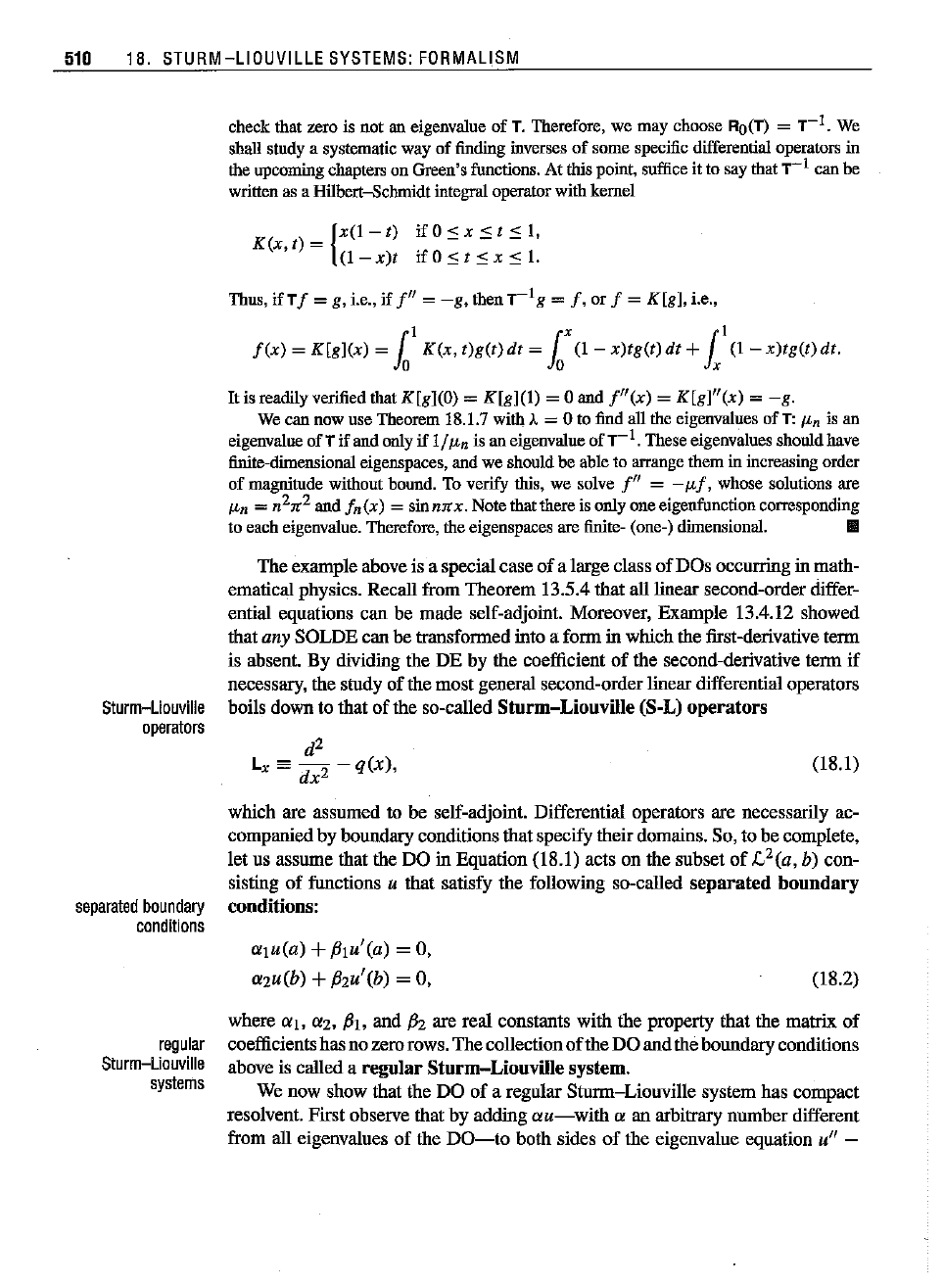
510 18. STURM-LIOUVILLE
SYSTEMS:
FORMALISM
check
that
zerois not an
eigenvalue
of
T.
Therefore,
we maychoose
Ro(n
= T-
1.
We
shallstudya
systematic
way of
finding
inverses
of some specific
differential
operators
in
the
upcoming
chapters
on
Green's
functions.
At thispoint,sufficeit tosay
that
T-
1
canbe
written
as aHilbert-Schmidt
integral
operator
withkernel
K(x,t)
=
{X(I-t)
if 0
~
x
~
t s I,
(I -
x)t
if 0
~
t
~
x
~
I.
Thus,ifT
1=
g, i.e.,if
I"
=
-g,
then
rig
=
I,
or
1=
K[g],
i.e.,
I(x)
=
K[g](x)
=f
K(x,
t)g(t)
dt
=
fox
(I
-
x)tg(t)
dt
+
{(I
-
x)tg(t)
dt.
lt
isreadilyverified thatK[g](O) =
K[g](l)
=0 and
!,,(x)
=
K[g]"(X)
=
-g.
We can now use Theorem 18.1.7
with)"
= 0 to find all the eigenvalues ofT:
/Ln
is an
eigenvalue
of T if andonly
if
1/
Jkn
is aneigenvalue of
T-
1.
These
eigenvalues shouldhave
finite-dimensional
eigenspaces, andwe shouldbe ableto
arrange
themin
increasing
order
of
magnitude
without
bound.
Toverifythis,we solve
I"
=
-J.L!.
whose
solutions
are
/Ln
=n
2
7f2
andIn(x) = sinmfx. Note
that
there
is onlyoneeigenfunction
corresponding
toeach
eigenvalue.
Therefore,
theeigenspaces are
finite-
(one-)dimensional.
l1li
The example above is a specialcase of a large class of DOs occurring in math-
ematical physics. Recall from Theorem 13.5.4 that all linear second-order differ-
ential equations can be made self-adjoint. Moreover, Example 13.4.12 showed
that any SOLDE can be transformed into a form in which the first-derivative term
is absent. By dividing the DE by the coefficient
of
the second-derivative term
if
necessary, the study of the mostgeneral second-orderlinear differential operators
boils down to that of the so-called
Sturm-Liouville
(S-L)
operators
which are assumed to be self-adjoint. Differential operators are necessarily ac-
companiedby boundary conditions that specify their domains. So, to be complete,
let us assume that the DO in Equation (18.1) acts on the subset
of
£,z(a, b) con-
sisting of functions
u that satisfy the following so-called
separated
boundary
conditions:
Sturm-Liouville
operators
separated
boundary
conditions
d
2
Lx
==
dx
2
-
q(x),
alu(a)
+
fhu'(a)
= 0,
azu(b) +fJzu'(b) = 0,
(18.1)
(18.2)
regular
Sturm-Liouville
systems
where
aI,
az,
fh,
and
fJz
are real constants with the property that the matrix of
coefficients has no zero rows. The collection
of
the DO and the boundaryconditions
above is called a
regular
Sturm-Liouville
system.
We now show that the DO of a regular Sturm-Liouville system has compact
resolvent. First observe that by adding
au-with
a an arbitrary number different
from all eigenvalues of the
DO-to
both sides
of
the eigenvalue equation u" -

18.1
UNBOUNDED
OPERATORS
WITH
COMPACT
RESOLVENT
511
qu = AU,we canassume" thatzerois notaneigenvalue of
Lx.
Next,suppose that
Ut(x)
and
uz(x)
are ihe two linearly independent solutions
ofihe
homogeneous
DE satisfying ihe first and ihe second boundary conditions of Equation (18.2),
respectively. The operator whose kernel is
K(x,
t) =
{-U1(X)UZ(t)/w(a)
if
a::o x
::0
t::o b,
-UI(t)UZ(x)/W(a)
if
a::o t::o x
::0
b,
in which W is ihe Wronskian
of
the solutions, is a Hilbert-Schmidt operator and
iherefore compact. We now show ihat
K(x,
t) is ihe resolvent Ro(L
x
) =
L.;-t
sa K
of our DO. To see this, write Lxu = v, and
uz(x)
1
x
Ut(x)
l
b
u(x)
=
K[v](x)
=
---
Ut(t)v(t)dt
-
-(-)
uz(t)v(t)dt.
W(a)
a
Wax
Differentiating this once gives
u
t
(x)
1
x
u';
(x)
l
b
u'
(x)
=
__
z_
UI
(t)v(t)
dt
-
_t_
uz(t)v(t)
dt,
W(a)
a
W(a)
x
and a second differentiation yields
u"(x)
1
x
u"(x)
l
b
u"(x)
=
__
z_
uI(t)v(t)dt
__
t_
uz(t)v(t)dt
+
v(x).
W(a)
a
W(a)
x
The last equationfollows from ihe fact ihatthe Wronskian
ui
Uz-
u;u
I is constant
for a DE
of
the form u"
-qu
=
O.
By substituting
ul
=
qu;
andu~
=
qu:
in ihe
last equation, we verify ihat
u =
K[v]
is indeed a solution
ofihe
Sturm-Liouvi1le
system Lxu = v.
Next, we show that ihe eigensolutions of ihe S-L system are nondegenerate,
i.e., ihe eigenspaces are one-dimensional. Suppose
II
and
[z
are any two eigen-
functions corresponding to ihe same eigenvalue. Then boihmust satisfy ihe same
DE and the Same boundary conditions; in particular, we must have
at!t(a)
+
fhI{(a)
=
0,
'*
(!t(a)
I{(a))
(at)
_
(0)
at!z(a)
+
fhI~(a)
= 0
jz(a)
I~(a)
fJt
- 0 .
(18.3)
If
at
and
fJI
are not boih zero, ihe
Wronskian-ihe
determinant
of
ihe matrix
above-must
vanish. Therefore, ihe two functions must be linearly dependent.
Finally, recall ihat a Hilbert space on which a compact operator K is defined
can be written as a direct sum
of
ihe latter's eigenspaces. More specifically,
9{
=
'£-7=0
EIlJV(
j,
where each
JV(
j is finite-dimensional for j = 1, 2,
...
, and
6
Although
this will change
q-and
the originaloperator-no
information
will be lost becausetheeigenvectors will be the
sameandall eigenvalues will be
changed
bya.
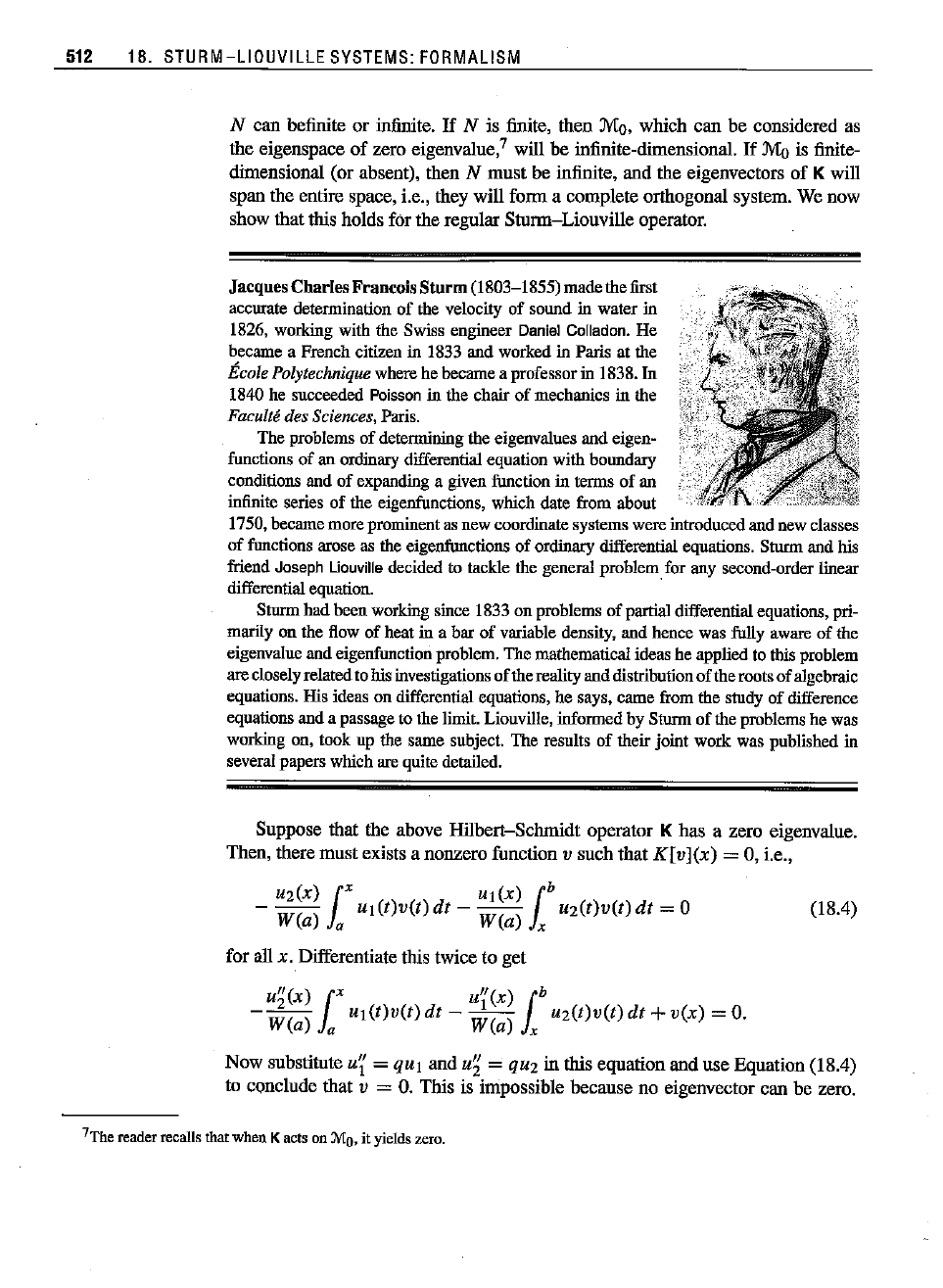
(18.4)
512
lB.
STURM-LIOUVILLE
SYSTEMS:
FORMALISM
N can befinite or infinite.
If
N is finite, then
Mo,
which can be considered as
the eigenspace of zero eigenvalne,7 will be infinite-dimensional.
If
Mo
is finite-
dimensional (or absent), then N mnst be infinite, and the eigenvectors of K will
span the entire space, i.e., they will form a complete orthogonal system. We now
show that this holds for the regular Sturm-Liouville operator.
Jacques Charles FraucoisSturm
(1803-1855)madethefirst
accurate
determination
of the velocity of soundin
water
in
1826,
working
with the Swiss engineer
Daniel
Colladon.
He
became
a
French
citizenin 1833 and
worked
in
Paris
at the
EcolePolytechnique
where
he
became
a
professor
in 1838.In
1840he succeeded
Poisson
in the
chair
of mechanics in the
Pacuue
des Sciences,
Paris.
The
problems
of determining theeigenvalues andeigen-
functions
of an
ordinary
differential
equation
with
boundary
conditions andof
expanding
a given
function
in tenus of an
infinite
seriesof theeigenfunctions, which
date
from
about
1750,becamemore
prominent
asnewcoordinate systemswere
introduced
andnewclasses
of
functions
aroseas theeigenfunctions of
ordinary
differential
equations.
Sturm
andhis
friend
Joseph
Liouville
decided
to
tackle
the
general
problem
for
any
second-order
linear
differential
equation.
.
Sturm
hadbeen
working
since1833on
problems
of
partial
differential
equations,
pri-
marily
ontheflowof heatin a
bar
of
variable
density,
andhencewasfully
aware
of the
eigenvalue
and
eigenfunction
problem.
The
mathematical
ideas
he
applied
tothis
problem
areclosely
related
tohis
investigations
of
the
reality
and
distribution
of the
roots
of
algebraic
equations.
His
ideas
on
differential
equations,
he says,came
from
the
study
of
difference
equations
anda
passage
tothe
limit.
Liouville,
informed
by
Sturm
ofthe
problems
hewas
working
on, tookup thesame
subject.
The
results
of
their
jointworkwas
published
in
several
papers
which
are
quite
detailed.
Suppose that the above Hilbert-Schmidt operator K has a zero eigenvalue.
Then, there must exists a nonzero function
v such that
K[v](x)
= 0, i.e.,
U2(X)1
x
Ut(x)
l
b
-
--
Uj
(t)v(t)
dt
-
--
U2(t)V(t)
dt
= 0
W(a)
a
W(a)
x
for all x. Differentiate this twice to get
U"(x)
r
u"(x)
l
b
- .Ji(a)
J
a
Ut
(t)v(t)
dt
-
~(a)
x U2(t)V(t)
dt
+
v(x)
=
O.
Now substitute
ur
= qUj and U
z
= qU2 in this equation and use Equation (18.4)
to conclude that v =
O.
This is impossible because no eigenvector can be zero.
7The
reader
recalls
that
whenKactsonMo, it yieldszero.
